
This article was updated on July 29th, 2023
It is extremely common for dogs to develop lumps and bumps anywhere on their body. They can range in size, location, and appearance, and be especially concerning for pet parents. There are many different kinds of growths, both benign and malignant; thus, it is always best to have your vet evaluate any new lump and bump that you find on your dog. Luckily, hair follicle cysts are a common type of benign cyst that can be cured with surgical removal.
What Are Hair Follicle Cysts?
A cyst is defined as a hollow space within a tissue containing either liquid or solidified material. There are several different types of cysts, which have different origins, characteristics, and appearances.
- True cysts – Contain a membrane/lining that produces the secretions (such as a sweat gland).
- Follicular cysts – Inflammation or infection associated with the base of a hair follicle can lead to a follicular cyst, which may contain fluid or thick cheesy material and is prone to becoming infected by yeast or bacteria. They are closely related to comedones (blackheads). Additional names for follicular cysts include epidermoid cysts.
- Sebaceous cysts – Develop from an accumulation of oily sebum in or around sebaceous glands. This type of cyst also commonly becomes infected.
- Dermoid cysts – A rare type of cyst that is formed before birth.
- False cysts – Do not contain a membraneous lining. These are often caused by an injury, leading to the accumulation of blood or dead tissue.
You can read more about different types of cysts here.
What Do Hair Follicle Cysts Look Like? [With Pictures]
Hair follicle cysts appear as bumps or nodules on or under a dog’s skin. They may be firm, irregular, or smooth, and vary in size, as shown on the two pictures below:
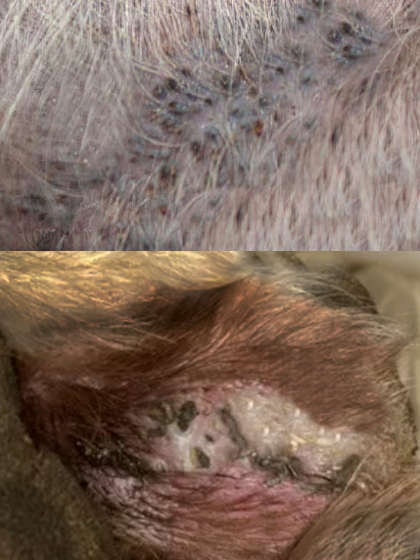
They typically contain solidified material which is described as cheesy in texture, white, brown, grey, or yellow in color, and may have a foul odor. They are commonly seen on the head, neck, and trunk, but can occur anywhere on the body.
It is common for hair follicle cysts to become infected, rupture, and bleed. Cysts are often a cosmetic issue, however, if they increase in size or get infected they may become itchy and painful for your dog. The photo below shows a follicular cyst that has ruptured and is bleeding:
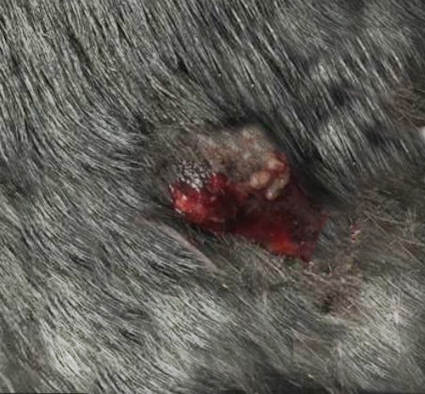
Here is a link to pictures of comedones (blackheads) and follicular cysts in a hairless dog. Hairless breeds are often predisposed to these issues.
How To Identify Hair Follicle Cysts – Key Characteristics
As described above, cysts have some key characteristics that may help your vet identify them:
- Firm bump found on or under a dog’s skin
- Often contain a cheesy material
- Frequently become infected and may rupture and bleed
- Most common on the head, neck, and trunk
However, in order to diagnose a hair follicle cyst, your vet will also need to collect a sample from the area. This may be done via a fine needle aspirate, in which a needle is inserted into the mass to collect a sample of cells for examination under the microscope. Additionally, they may elect to do a biopsy, in which part or all of the growth is removed and submitted for evaluation (histopathology). Not only can this identify the type of growth, but it is also often curative. Due to the numerous types of lumps and bumps that dogs can develop, it is important to pursue testing to rule out more serious causes, such as skin cancer.
Where & How Hair Follicle Cysts Form – Main Causes
Follicular cysts are caused by inflammation or infection at the base of a hair follicle. This most commonly occurs due to an injury to the area (sometimes on a pressure point) or blockage of a hair follicle. Underlying allergies or skin infections can also predispose dogs to follicular cysts. Certain breeds, such as hairless dogs, terriers, and hounds, are also more at risk, although cysts can be seen in any breed.
Are Hair Follicle Cysts Dangerous or Painful for Your Dog?
Hair follicle cysts are not dangerous, however, they can become itchy, painful, and infected. They can also rupture, bleed, and scab, especially if your dog is scratching or chewing at the area. If this is the case, you will need to see your vet to discuss surgical removal.
It is also important to note that other types of skin cancer may have a similar appearance to a cyst but require much more extensive treatment. For this reason, it is important to have any new lump or bump evaluated by your vet.
Will a Follicular Cyst On a Dog Go Away On Its Own?
A follicular cyst will not go away on its own without surgical removal. Unless the entirety of the cyst is removed, it is likely to recur in the same location. The same is true if a cyst is expressed (popped) or ruptures on its own.
Can I Treat a Follicular Cyst at Home?
There is no treatment for a follicular cyst at home, however, not all follicular cysts require treatment. If a cyst is not bothering your dog, you may elect to monitor it for any change in size or appearance. It will be important to keep your dog from licking, chewing, or scratching at it. You should not pick at or try to express material from the cyst. If the cyst has become bothersome for you or your dog, it will require surgical removal.
Do All Follicular Cysts Need Treatments? How to Find out If Your Dog’s Hair Follicle Cyst Needs an Intervention
Cysts are not cancerous, however, they can cause issues for your dog due to size, location, and secondary infection. If a cyst is not infected, too large, or painful for your dog, your vet may just recommend monitoring it.
If you notice the following, please make an appointment with your vet right away:
- Rapid increase in growth
- Change in color or appearance
- The location of the cyst is affecting your dog’s mobility or other functions
- Your dog is scratching, licking, or biting at the cyst
- The cyst appears infected or has ruptured and is oozing blood or pus
Treatment Options & Recovery
If a cyst is bothering you or your dog, the recommended treatment is surgical removal. In most cases, this will be completely curative, although your dog may develop additional cysts elsewhere on their body. If a cyst appears infected, antibiotics will likely be indicated.
Below is a video showing a procedure to remove a follicular cyst in a dog using electrocautery:
The cost of surgery will depend on the size and location of the cyst, your dog’s overall health, and your location. Small cysts may be able to be removed with sedation and local anesthetic, while larger ones will require anesthesia. Your vet will likely recommend a complete physical exam and bloodwork to evaluate your dog’s health and major organ function before proceeding with surgery, and submission of the mass afterward for histopathology to determine the exact cause and confirm that it has been completely removed.
After surgery, the incision will need to be kept clean and dry. You may be sent home with pain medications and antibiotics. Your dog will have to wear an E collar and take it easy for approximately 10-14 days until their sutures are removed.
Can Hair Follicle Cysts be Prevented?
In general, cysts cannot be prevented. The exception may be making sure that any allergies or skin infections are well controlled. If you notice a cyst on your dog, it will be important to prevent them from chewing, licking, or scratching at it. This can lead to additional irritation, ulceration or rupture of the cyst, and infection.
Related posts:
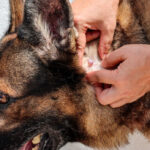 Types of Cysts Often Found on a Dog’s Neck or Head [Vet Advice] - Canine cysts of the head and neck are fairly common and most of them don’t cause serious problems. There are… [...]
Types of Cysts Often Found on a Dog’s Neck or Head [Vet Advice] - Canine cysts of the head and neck are fairly common and most of them don’t cause serious problems. There are… [...]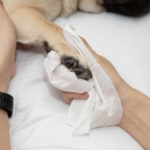 4 Cysts Often Found on Dog Paws [With Pictures & Vet Advice] - Ahh dog feet, giant Great Dane Marmaduke paws, tiny terrier tootsies, the puffy, fluffy white feet of a Bichon Frisé.… [...]
4 Cysts Often Found on Dog Paws [With Pictures & Vet Advice] - Ahh dog feet, giant Great Dane Marmaduke paws, tiny terrier tootsies, the puffy, fluffy white feet of a Bichon Frisé.… [...]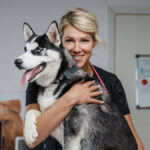 Eyelid Cysts in Dogs: FAQ With Our Veterinarian - Eyelid cysts are very common, particularly in older dogs. Oftentimes, an owner is unaware that they’re present as they can… [...]
Eyelid Cysts in Dogs: FAQ With Our Veterinarian - Eyelid cysts are very common, particularly in older dogs. Oftentimes, an owner is unaware that they’re present as they can… [...]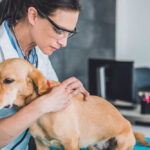 Burst or Ruptured Cysts on Dogs: Our Vet Shares What to Do - When a dog does come into my clinic with a ruptured cyst, the owner can be quite alarmed by the… [...]
Burst or Ruptured Cysts on Dogs: Our Vet Shares What to Do - When a dog does come into my clinic with a ruptured cyst, the owner can be quite alarmed by the… [...] Eye Cysts in Dogs: Pictures & Vet Advice - Introduction: about eye cysts in dogs Finding an unexpected growth or mass on your dog can be distressing, but it… [...]
Eye Cysts in Dogs: Pictures & Vet Advice - Introduction: about eye cysts in dogs Finding an unexpected growth or mass on your dog can be distressing, but it… [...]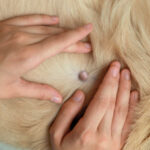 6 Types of Cysts in Dogs [With Pictures], and How to Treat - As a practicing veterinarian for over 17 years, I have treated hundreds of dogs with cysts. Cysts are a very… [...]
6 Types of Cysts in Dogs [With Pictures], and How to Treat - As a practicing veterinarian for over 17 years, I have treated hundreds of dogs with cysts. Cysts are a very… [...]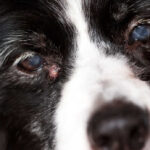 Sebaceous Cysts in Dogs [Pictures & Veterinarian Advice] - Sebaceous Cysts in dogs is one health issue for which dog owners should be watchful, but thankfully, they are rarely… [...]
Sebaceous Cysts in Dogs [Pictures & Veterinarian Advice] - Sebaceous Cysts in dogs is one health issue for which dog owners should be watchful, but thankfully, they are rarely… [...]Disclaimer: This website's content is not a substitute for veterinary care. Always consult with your veterinarian for healthcare decisions. Read More.

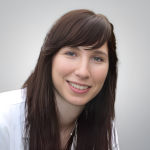

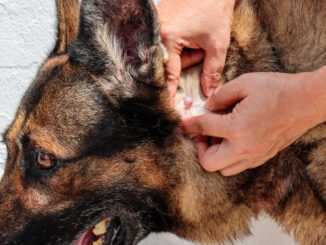
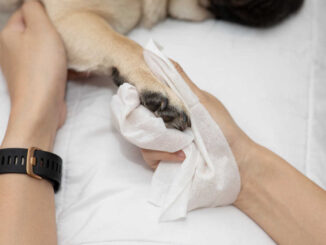
Be the first to comment